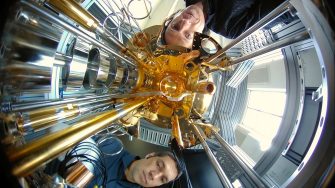Mechanical Coupling to Nuclear Spins
Our research focusses on the interactions between mechanical strain and donor nuclei.
Our research focusses on the interactions between mechanical strain and donor nuclei.


Mechanical strain is a fundamental effect that can enhance the performance of electronic and quantum devices, such as transistors [Thompson2006, opens in a new window] and quantum wells [Corley-Wiciak2023, opens in a new window]. High-spin nuclei, such as the spin-7/2 123Sb, contain a quadrupole moment that enables both electrical (nuclear electric resonance or NER) and mechanical [Pickens1984, opens in a new window] (nuclear acoustic resonance or NAR) control of spin state transitions.
Our group demonstrated NER of an 123Sb donor in a silicon-based quantum device [Asaad2020, opens in a new window], which led to simulation of a piezoelectric quantum device capable of achieving NAR of an 123Sb donor [O’Neill2021, opens in a new window]. The AlN-based piezoelectric actuator produces an oscillating strain in the donor-implanted silicon device that mechanically drives 123Sb nuclear spin state transitions. We plan to extend these experiments to large mechanical resonators capable of strong spin-phonon coupling, with the aim of investigating the quantum nature of gravity.
O’Neill, L. A., Joecker, B., Baczewski, A. D. and Morello, A., Engineering local strain for single-atom nuclear acoustic resonance in silicon, Applied Physics Letters 119, 174001 (2021), opens in a new window.
Juha Muhonen, opens in a new window at University of Jyväskylä, Benjamin Joecker, opens in a new window at University of Copenhagen, David N. Jamieson, opens in a new window at University of Melbourne, Fay Hudson at UNSW Sydney, Andrew Dzurak at UNSW Sydney, Kohei M Itoh, opens in a new window at Keio University.